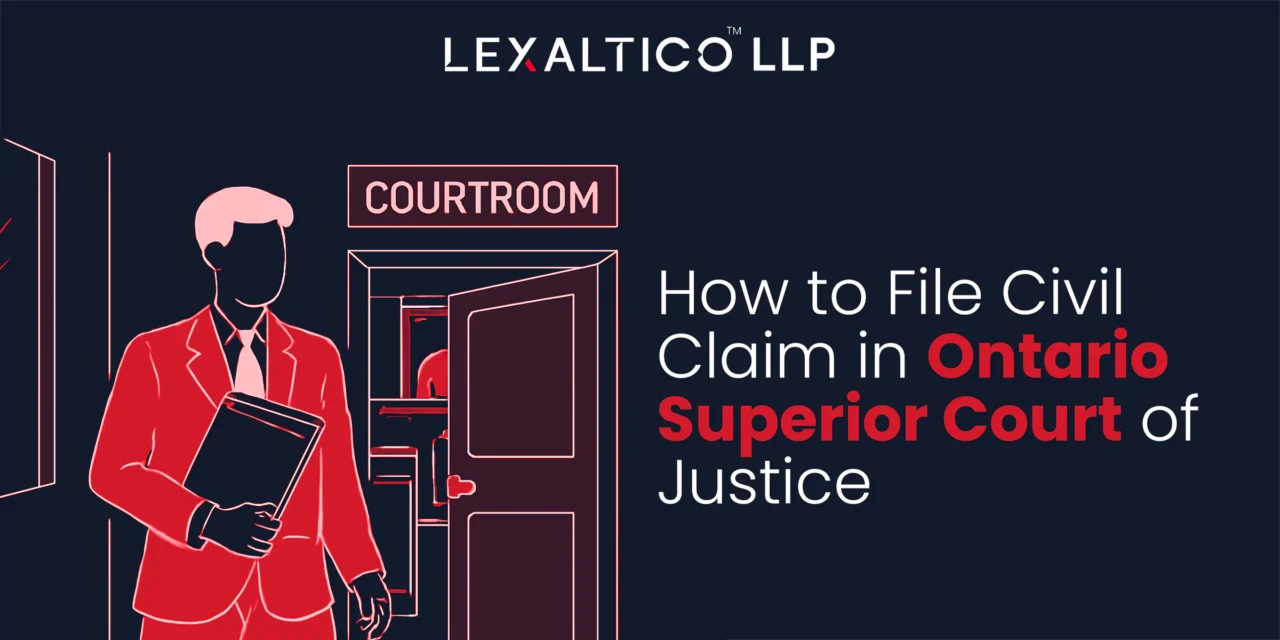A civil claim in Ontario is a legal way to resolve disputes between individuals, businesses, or organizations. These disputes often involve money, property, or injury. Whether you’re looking to recover damages or defend yourself, understanding the steps in the civil litigation process is key.
Let’s walk through how to file a civil lawsuit in Ontario, what to expect, and how to manage each stage in the court system.
Where Civil Claims Are Heard in Ontario
In Ontario, most civil cases are handled by the Superior Court of Justice. This court deals with many legal issues, including personal injury, business disputes, and estate matters. If the value of your claim is under $35,000, your case may go to Small Claims Court instead.
The Divisional Court, which is part of the Superior Court, handles appeals and judicial reviews. It’s commonly used when someone wants to challenge a decision made by a government body or tribunal.
Small Claims vs. Superior Court: Which to Choose?
Before you start a civil claim in Ontario, it’s important to know where your case belongs.
- Small Claims Court: For cases up to $35,000. It’s faster and has lower fees.
- Superior Court of Justice: For claims over $35,000. If your case is up to $200,000, it follows the simplified procedure.
Starting in the wrong court could lead to extra costs. So, choose carefully based on your claim amount limit in Ontario.
How to Start a Civil Claim in Ontario

To start a civil claim in the Superior Court of Justice, you must follow several steps. This process is outlined in the Rules of Civil Procedure.
Here’s a quick overview:
- Prepare a Statement of Claim or Notice of Action
- Pay the court filing fees in Ontario
- Serve the documents on the defendant
- File proof of service with the court
Once these are done, your claim is officially started.
Filing Court Documents in Ontario
You can file court documents in Ontario in several ways:
- Online: Use the Civil Claims Online portal or the Civil Submissions Online portal.
- By Mail or In Person: Go to the local court registry.
- By Email: Only allowed if your court date is within five business days.
Each court document must be named properly and follow the format rules. Make sure to include your court file number and contact information.
Serving Documents in the Superior Court of Justice
After you file your documents, the next step is serving court documents to the defendant. This means giving the other party a copy of your claim. It must be done within six months and follow Rule 16 of the Rules of Civil Procedure.
You’ll also need to file an Affidavit of Service to prove that the documents were served properly.
The Simplified Civil Claim Process in Ontario
If your civil claim is $200,000 or less, you must follow the simplified procedure. This is set out in Rule 76 of the Rules of Civil Procedure. It’s quicker and less expensive than the full trial process.
This applies to claims involving:
- Money
- Personal property
- Real estate (like land)
Steps to File a Civil Claim in Ontario (Simplified Procedure)

Here’s a step-by-step breakdown of the civil claim process in Ontario using the simplified procedure:
Step 1: Start the Civil Claim as the Plaintiff
If you’re the one starting the claim, you’re called the plaintiff. Your first step is to prepare and submit the right documents to the Superior Court of Justice.
You’ll need to complete one of the following:
- Statement of Claim (Form 14A or 14B)
- Notice of Action (Form 14C), use this if you need more time to finish your full claim
Along with your form, you also need to include this statement at the beginning of your claim:
“This action is brought against you under the simplified procedure provided in Rule 76 of the Rules of Civil Procedure.”
You must then:
- Pay the court filing fees
- Submit your claim online or in person
- Receive a stamped copy with a court file number
After filing, you’ll need to serve the documents to the person or business you’re suing (the defendant). You have six months to do this. After that, file an Affidavit of Service (Form 16B) to confirm the documents were delivered properly.
Step 2: Defendant Responds to the Civil Claim
If you are the defendant, you must act quickly after being served. You have a few choices:
- File a Statement of Defence (Form 18A)
- Try to settle the case with the plaintiff
- Do both: defend and negotiate
If you need more time to prepare your defence, you can file a Notice of Intent to Defend (Form 18B). This gives you 10 extra days to file your full defence.
You must:
- Serve your defence on the plaintiff
- File the defence and Affidavit of Service with the court
- Pay any required filing fees
If you miss the deadline, the plaintiff can ask the court to hold you in default, and they may win automatically.
Step 3: Pleadings Close
“Pleadings” are the official court documents both sides use to explain their position.
These include:
- The Statement of Claim
- The Statement of Defence
- Optional replies or counterclaims
Once all these documents are exchanged and no more responses are expected, the pleadings are considered closed. This allows the case to move forward to the next stage.
Step 4: Discovery Process
In the discovery stage, both parties share information and documents about the case. This includes:
- A list of all relevant documents in your possession (Affidavit of Documents – Form 30A or 30B)
- Copies of those documents for the other side
- Optional oral questioning, called examination for discovery
You must complete discovery within 10 days after pleadings close (The Affidavit of Documents must be served within 10 days of pleadings closing, not the entire discovery process). This step helps both sides prepare for trial and can also lead to early settlement.
Step 5: Mediation and Settlement Discussion
In cities like Toronto, Windsor, and Ottawa, mediation is mandatory. You and the other party will meet with a neutral person (a mediator) to try and settle the case.
Also, within 60 days after the defence is filed, you must have a settlement discussion. This can be done over the phone or in person. The goal is to talk openly about the issues and possibly agree on a solution.
Step 6: Set the Case Down for Trial
Once the main steps are done, it’s time to tell the court that the case is ready for trial. This is called setting the action down for trial.
To do this, the plaintiff must:
- Serve and file Form 76C (Notice for Pre-Trial Readiness)
- Include an Affidavit of Service
This must happen no more than 180 days after the defence is filed. If the plaintiff doesn’t do this, the defendant can take the step instead.
Step 7: Pre-Trial Conference
A pre-trial conference is a meeting with a judge or associate judge. All parties must attend.
The meeting helps:
- See if the case can be settled
- Plan how the trial will be handled
- Set limits on how long each side can present their case (max 5 days)
Before the meeting, all parties must prepare and share:
- A trial management plan
- A list of witnesses
- Key documents they plan to use
- Any expert reports
This must be done 30 days before the pre-trial, and filed with the court 5 days before the meeting.
Step 8: Bring a Motion (If Needed)
A motion is a request you make to the court before trial. You might use it to ask for more time, dismiss a part of the case, or solve a disagreement about documents.
In simplified cases, you must use Form 76B (Motion Form).
Motions can be:
- Agreed upon by both parties (called “on consent”)
- Disputed (called “contested”)
You can also ask for a summary judgment. This is when you want the judge to make a decision without a full trial, if there’s no serious dispute.
Step 9: The Trial
Finally, the case goes to trial. The trial is limited to five days under the simplified procedure. Each side has a chance to:
- Make an opening statement
- Present their evidence (mostly by written affidavits and past discovery answers)
- Question the other side’s witnesses (if allowed)
The court uses a trial record, which contains all pleadings, orders, and other required documents. This must be served on all parties and filed with the court 10 days before the trial starts.
At the end of the trial, the judge makes a decision.
Filing Online: Civil Claims and Divisional Court
You can file civil or Divisional Court documents online using:
- Civil Claims Online portal: For automatic filing and issuing
- Civil Submissions Online: For fee waivers and other documents
You’ll get a confirmation email once the court accepts your documents. Always double-check your attachments before submitting.
What If You Don’t Follow the Simplified Procedure?
If you should have used the simplified process but didn’t, the court may:
- Refuse to award you legal costs
- Order you to pay the other side’s costs
You can correct this by filing Form 76A to change your case to a simplified procedure.
Legal Representation and Self-Representation
You can choose to represent yourself or hire a lawyer. However, legal representation is highly recommended. A lawyer understands the civil court procedure in Ontario and can help you avoid mistakes.
Conclusion: Get Help with Your Civil Claim
Filing a civil claim in Ontario can feel overwhelming, but breaking it down makes it easier to manage. From deciding where to file, to following each court step, it’s important to stay organized and meet deadlines.
If you’re unsure about your next move, talk to a lawyer. They can guide you through how to file a claim in Ontario Superior Court or help with serving documents in civil litigation.
Quick FAQs
You must prepare and file a Statement of Claim or Notice of Action, pay the court fee, and serve the documents to the defendant. You can file documents online or in person at the courthouse.
There is no official minimum, but claims under $35,000 are usually better suited for Small Claims Court. The Superior Court is generally used for claims over that amount.
No, you can represent yourself, but the process can be complex. A lawyer can help you follow the rules and avoid costly mistakes.
Small Claims Court handles civil claims under $35,000 and has a simpler process. The Superior Court deals with larger claims and follows stricter procedures.
Filing fees usually start at around $229, but the amount depends on the documents and stage of the case. If you can’t afford the fees, you may apply for a fee waiver.
You must deliver the claim to the defendant using a method allowed under Rule 16 of the Rules of Civil Procedure. Then, file an Affidavit of Service with the court.
You need a Statement of Claim or Notice of Action, and in some cases, an Information for Court Use form. These documents must be served and filed with the court.
It can take several months to over a year, depending on the complexity of the case. The simplified procedure aims to move things along faster.
Yes, most civil claims can be filed online using the Civil Claims Online or Civil Submissions Online portals. Make sure your documents are in the right format.
The court will issue your claim and give you a file number. You must then serve it on the defendant and wait for them to respond.
Disclaimer: The information provided in this blog is for general informational purposes only. It is not legal advice and should not be relied on as such.



